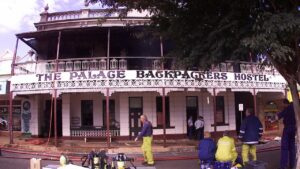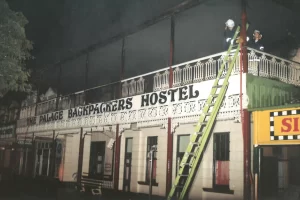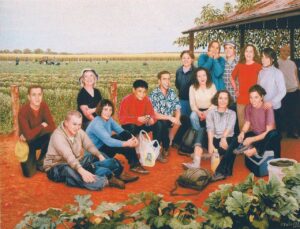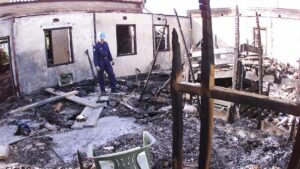
 Hiking and Backpacking have been a favorite pastime for many people for many years, and some people go to greater lengths and distances than others. Backpacking in Australia is a trip on the bucket lists of a lot of people. On their hikes, many people have made the Childers Palace Backpackers Hostel one of their stops. Located in the former Palace Hotel in the town of Childers, Queensland, Australia, the building had been converted into a backpacker hostel. That was the stop for 15 backpackers on June 22, 2000. They had been hiking all day and were ready for some downtime. After a relaxed evening, they all went to bed. There were 88 people staying in the building that night, but the building could house 101 people.
Hiking and Backpacking have been a favorite pastime for many people for many years, and some people go to greater lengths and distances than others. Backpacking in Australia is a trip on the bucket lists of a lot of people. On their hikes, many people have made the Childers Palace Backpackers Hostel one of their stops. Located in the former Palace Hotel in the town of Childers, Queensland, Australia, the building had been converted into a backpacker hostel. That was the stop for 15 backpackers on June 22, 2000. They had been hiking all day and were ready for some downtime. After a relaxed evening, they all went to bed. There were 88 people staying in the building that night, but the building could house 101 people.
At about 12:30am on June 23, 2000, a fire started in the downstairs recreation room and quickly spread up the walls and into the stairwell. The first emergency call came from a pay phone across the street, and it was logged at 12:31am. Emergency services first arrived at 12:38am and spent four hours battling the fire before it was fully extinguished. In the aftermath, it was found that 15 backpackers, nine women and six men, had lost their lives. Survivors told of how smoke quickly filled the area and how the building’s power was lost. They struggled in the darkness to find a way out, and in the absence of alarms and emergency lighting, some people attempted to awaken and rescue as many people as they could. Of the 70 backpackers who survived the fire, 10 suffered minor burns and injuries as they tried to escape from the upper level and by jumping onto the roofs of the neighboring buildings. In this fire, those who got out lived, those who died did not get out at all.
Of the 15 who died in the fire, seven were British, three were Australian, two were from the Netherlands, and one each from Ireland, Japan, and South Korea. It took a while to identify the dead, because there was an incomplete hostel register. It recorded check-ins, but unfortunately not departures. To further complicate things, most of the residents’ passports were destroyed or damaged by the fire. DNA samples were also difficult to obtain for those with no relatives in Australia. Most of the backpackers who died were on the first floor of the hostel. Through an inquest, it was found that in one of the upper rooms where 10 victims were found, which was all of the occupants of that room, a bunk bed blocked a fastened exit door, and the windows were barred. They had little chance of escape.
It was found that a fruit packer named Robert Paul Long, had moved into the hostel on March 24, 2000, but had been evicted on June 14, 2000, over a matter of $200 rent in arrears. Long didn’t leave the area, as was seen in ATM records that showed him in the area in the week before the fire. Long, who had expressed a hatred of backpackers, had also earlier threatened to burn down the hostel. Around midnight, prior to the fire, two guests saw Long in the back yard of the hostel. Long had asked them to leave the door open so he could assault his former roommate, an Indian national. They declined, and he told them that he still had a key. Another guest recounted how he had woken up around midnight to find Long downstairs using a PC near a burning rubbish bin. After the guest protested the reckless actions, Long took the bin outside, and the guest went back to bed, but was awakened later to banging sounds, shouting, and thick black smoke.
After the fire, Long tried to mask his movements, but he was later spotted in cane-fields about five days later. At that time, he was arrested in bush-land near Howard, which is less than 20 miles from Childers. As he was being arrested, Long stabbed a police dog after being bitten. Then, he stabbed one of the officers in the jaw and the second officer shot Long in the shoulder. In March of 2002, Long was found guilty of two charges of murder (for the dead Australian twins) and arson and sentenced to life in prison. While it seems strange to only charge him with the deaths of two of the 15 victims, it was thought that it would expedite the proceedings and to allow for other charges to be brought in the event of an acquittal. Following his conviction, Long filed an appeal in 2002, which was denied. In June 2020 he became eligible for parole, but his February 2021 parole appeal was rejected. He could become eligible again in 1 year.
After the fire, and many people losing everything they owned, survivors were temporarily housed locally at the Isis Cultural Centre. Japan’s embassy officials quickly evacuated five Japanese nationals, which eased things a little. Residents of Childers knitted blankets and donated food and backpacks for the survivors. Residents also invited survivors for meals and showers and local businesses assisted with food, clothing, and personal items. Media, politicians, and investigators came to the site as well and Princess Anne visited on July 2nd, to meet the surviving backpackers and others involved in the disaster.
The results of a coronial inquest were released in 2006. “The hostel, a 98-year-old, two-story timber building, did not have working smoke detectors or fire alarms. It was later reported that the owner had installed fire alarms in the building, but they had been disabled weeks prior to the fire due to regular malfunctioning. It was also mentioned that batteries for the stand-alone alarms were sometimes removed by customers for portable cameras or music players.” When it was announced that the coroner had decided not to charge the owner and operators of the hostel for negligence, families of seven victims filed a class action suit against them.

 On October 26, 2002, the renovated structure, renamed the Palace Memorial Building, opened and the opening ceremony was attended by some 250 invited guests, including members of 12 of the families of those who died. Frank Slarke, the father of the dead Australian twins, read a poem he wrote as a eulogy. Since then, over one million visitors have visited the building.
On October 26, 2002, the renovated structure, renamed the Palace Memorial Building, opened and the opening ceremony was attended by some 250 invited guests, including members of 12 of the families of those who died. Frank Slarke, the father of the dead Australian twins, read a poem he wrote as a eulogy. Since then, over one million visitors have visited the building.


Leave a Reply